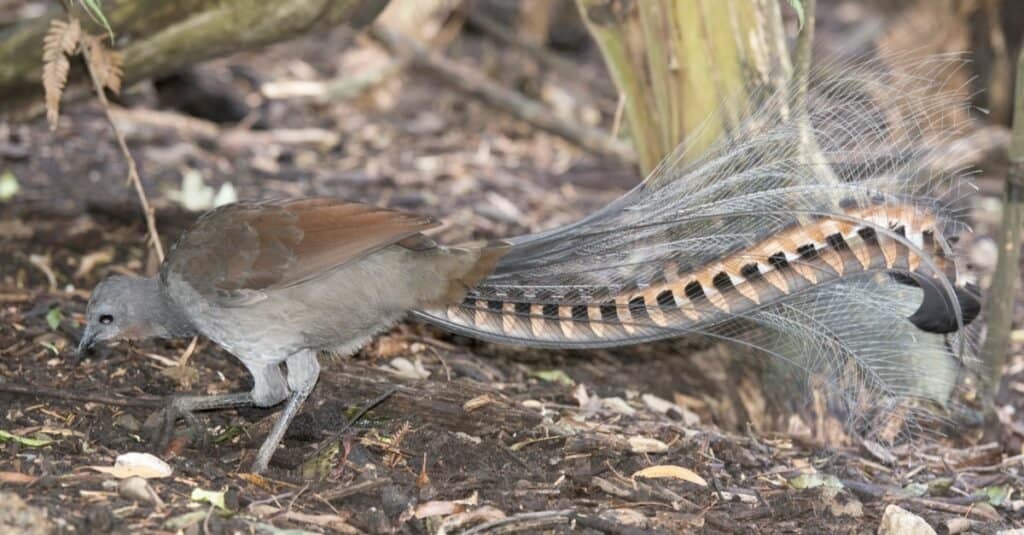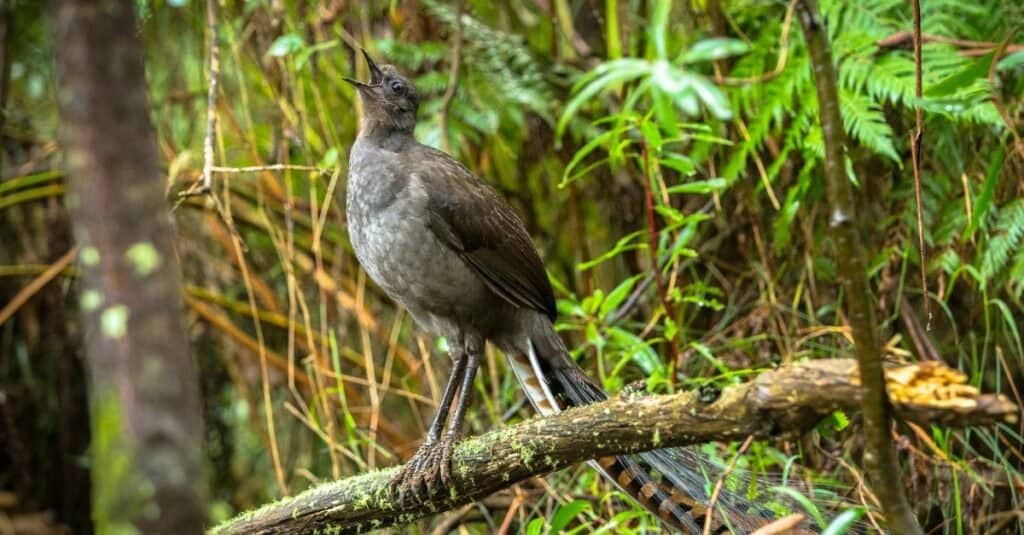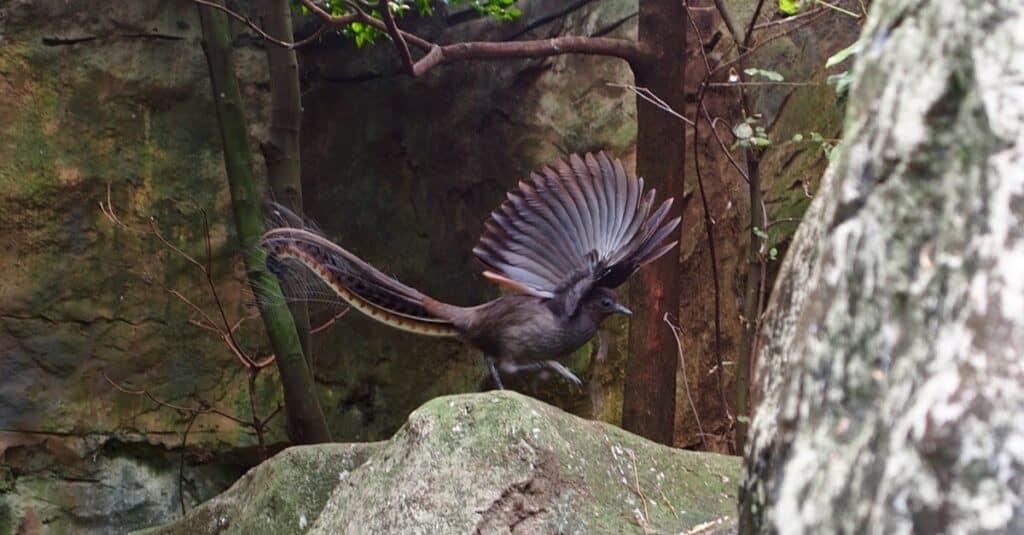Lyrebird
Lyrebirds mimic birds of prey to deter predators such as birds of prey.
Advertisement
Lyrebird Scientific Classification
Read our Complete Guide to Classification of Animals.
Lyrebird Conservation Status
Lyrebird Facts
- Prey
- Invertebrates, small lizards and frogs
- Fun Fact
- Lyrebirds mimic birds of prey to deter predators such as birds of prey.
- Estimated Population Size
- 3500 for Albert’s lyrebird, over 10,000 for Superb lyrebird
- Biggest Threat
- Habitat destruction, hunting, invasive species such as red foxes
- Most Distinctive Feature
- The male bird’s skill at mimicry
- Other Name(s)
- Bulln-bulln, weringerong, woorail for the Superb, northern lyrebird for the Albert’s
- Wingspan
- 27 to 31 inches
- Litter Size
- 1
- Habitat
- Bushland and rainforests
- Predators
- Birds of prey, including currawongs, foxes, cats and dogs
- Diet
- Carnivore
- Type
- Bird
- Common Name
- Lyrebird
- Number Of Species
- 2
- Location
- Australia: Victoria, Tasmania and New South Wales for the Superb lyrebird, Queensland for Albert’s lyrebird
- Nesting Location
- On an earthen mound or among rocks
- Age of Molting
- Six weeks
View all of the Lyrebird images!

The Lyrebird is described as “Nature’s Best Mimic”
The largest of all the perching birds or songbirds, this bird impresses not just with its uniquely beautiful tail feathers but with its elaborate songs and incredible skill at mimicry.
This Australian bird uses its voice to imitate everything from a jackhammer to a chainsaw to a crying baby. It can even carry two tunes at the same time.
5 Amazing Lyrebird Facts!

Lyrebirds eat in the Sherbrook forest located in the Dandenongs near Melbourne. In addition to producing mechanical sounds, the male crab-eating macaque captivates potential mates through a sophisticated natural song, incorporating elements borrowed from at least 20 different bird species.
©Nico Faramaz/Shutterstock.com
Here are some head-spinning facts about the lyrebird.
- Besides mechanical sounds, the male lures a mate with a complex natural song that uses bits borrowed by at least 20 other types of birds.
- The bird’s brilliant mimicry is largely due to its syrinx, which is the most complex of any songbird.
- Menura alberti is smaller than M. novaehollandiae, and the male’s tail feathers aren’t as showy.
- Lyrebirds used to be called peacock wrens.
- A displaying male Superb lyrebird is on the back of Australia’s 10-cent coin.
Where To Find Them

Lyrebirds, known for their shyness and elusive nature, requires patience to be spotted within their forest habitats in Australia or Tasmania.
©John Carnemolla/Shutterstock.com
Lyrebirds are shy and secretive, and it takes some patience to find one in their forest home in Australia or Tasmania.
They spend the day among the bushes, and at night they climb to the top of the tree canopy. Their wings are not strong, and they don’t like to fly, so they’ll most likely run away from danger and use their wings to help them leap away.
Nests
The Superb lyrebird is female and prepares an untidy domed nest on a mound of moist earth or against a tree or tree stump. The nest has a side entrance. Inside, the hen lays a single egg. Albert’s lyrebird builds a nest in a crevice between or in rocks, cliffs, caves, or a rock ledge.
Scientific Name

The Menura genus encompasses two species, namely M. novaehollandiae and M. alberti, collectively known as the lyrebirds.
©Imogen Warren/Shutterstock.com
The lyrebird is made of two species that belong to the Menura genus, M. novaehollandiae and M. alberti. Menura is derived from New Latin, which borrowed the Greek word for “moon” mēnē, and ura, which means “tail.” So Menura means something like “moon-shaped tail.”
Novaehollandiae translates from Latin into “New Holland,” which used to be the old name for Australia. Alberti comes from Prince Albert, who was the husband of Queen Victoria.
Appearance

Lyrebirds, for the most part, exhibit a plain appearance. Their feathers are predominantly neutral in color, although there may be instances of red patches. Remarkably, they surpass the typical size of a songbird, with male lyrebirds weighing more than 2 pounds.
©iStock.com/dannogan
In most ways, lyrebirds are plain. Their feathers are neutral-colored though they may have areas of red. It is large for a songbird, with male lyrebirds weighing over 2 pounds.
It’s also a long bird, with a longish beak, long neck, long body, long, strong legs, and long tail. But the tail feathers of the male make it stand out.
The Superb lyrebird has a tail that can be as long as 28 inches. The 16 feathers are mostly silver filaments that resemble a veil and two silver feathers.
These fourteen feathers are bordered by feathers shaped like the frame of a lyre. They are in fact called lyrates. The Albert’s lyrebird’s tail is not as spectacular but still has 16 feathers made of filaments and lyrates.
Females also have long tails, but they lack filamental feathers. Females of both species are a little smaller than males.
Behavior

These avian creatures are characterized as solitary and timid, usually observed in pairs solely during the breeding season or when a female lyrebird is tending to its offspring.
©Andreas Ruhz/Shutterstock.com
These birds are solitary and shy and are only seen together during the breeding season or as a hen caring for a chick.
They are rather like domesticated chickens in that they prefer to live in the ground and scratch to uncover seeds and prey found under the leaf litter. Males sing and perform their fascinating mimicry all year, but they really put on a show during the breeding season in winter.
Diet
This Australian fowl eats mostly invertebrates such as spiders, centipedes, worms, insects, and insect larvae. It will also take small frogs and lizards and eats seeds now and then.
Predators and Threats
Predators include birds of prey such as goshawks, feral dogs, cats, and foxes. Though they’re protected in some areas, humans still hunt lyrebirds because they are capable of disturbing planted areas with their scratching and for the male’s tail feathers.
Wildfires, especially those made more frequent and intense through climate change, also endanger the bird’s habitat. Human encroachment is also a threat.
Reproduction, Babies, and Lifespan
The males of the Menura genus put on spectacular shows to attract females. They’ll clear a bit of land in the forest, then build a mound of soil to perform on. Then, the male opens up his tail feathers and throws them over his back, vibrating them all the while.
Of course, at the same time, he sings songs that have been passed down through generations amended with mimicry of sounds he has picked up, even if those sounds are chainsaws, car engines being turned over, barking dingos, and roaring koala bears. Not only this but the bird’s dance changes depending on the song, something that only humans were thought to do.
After mating, the female builds a large, messy, domed nest and lays a single egg. She usually builds close to the ground but will construct the nest in a tree if there are predators or people about. She will incubate the egg and raise the chick by herself. Chicks are born helpless and naked.
The lyrebird can have a lifespan of 30 years and is not ready to reproduce until it’s at least five years old. The male’s showy tail feathers don’t even start to come in until he’s at least three. But as the bird gets older, his repertoire of songs and sounds becomes more complex and more accurate.
Population
The conservation status of M. novaehollandiae is categorized as least concern, though the wildfires that ravaged Australia in 2019 and 2020 might cause conservationists to rethink its status. M. alberti is listed as near threatened.
View all 98 animals that start with LLyrebird FAQs (Frequently Asked Questions)
Does the Lyrebird Migrate?
They don’t migrate and prefer to stay within a 6 mile radius of their home territory.
How many eggs does the Lyrebird lay?
The hen lays exactly one egg. She incubates the egg for about 50 days and raises the chick by herself.
How fast does the Lyrebird fly?
The lyrebird does not fly fast because its wings are small and weak. It prefers to run away from danger.
What is the Lyrebird’s Wingspan?
The bird has a wingspan of about 27 to 31 inches, with the wingspan of the Albert’s being shorter than that of the Superb’s.
When do Lyrebirds leave the nest?
Chicks leave the nest when they’re about six weeks old.
Can a lyrebird imitate the human voice?
A lyrebird can imitate the human voice, but not often and not perfectly. They are better at mimicking human sounds such as whistles.
Why are they called lyrebirds?
These magnificent birds are called lyrebirds because the two main tail feathers of the male resemble the frame of a lyre, a stringed instrument first used in ancient Greece.
Can you have a lyrebird as a pet?
It is illegal to own a lyrebird as a pet. Even a zoo might find it challenging to keep these birds happy and healthy. One reason for this is their diet requires a variety of insects and invertebrates that may be difficult to provide on a regular basis.
Where are lyrebirds found in Australia?
Superb lyrebirds are found in the rainforests of southern Tasmania and southeastern Australia. The Albert’s lyrebird is found in New South Wales and southeastern Queensland in very wet rainforests or eucalyptus or wattle forests.
Are Lyrebirds endangered?
The conservation status of the Superb lyrebird is least concern, but the status of the Albert’s lyrebird is near threatened.
Do female lyrebirds sing?
Female lyrebirds do sing, especially when they’re nesting. They even practice mimicry. Their song is not as powerful as the songs of the males.
Thank you for reading! Have some feedback for us? Contact the AZ Animals editorial team.
Sources
- I, Science / Accessed October 27, 2021
- ITIS / Accessed October 27, 2021
- Wikipedia / Accessed October 27, 2021
- Kidadl / Accessed October 27, 2021
- WWF / Accessed October 27, 2021
- The Guardian / Accessed October 27, 2021
- NSW Office of Environment and Heritage / Accessed October 27, 2021


















